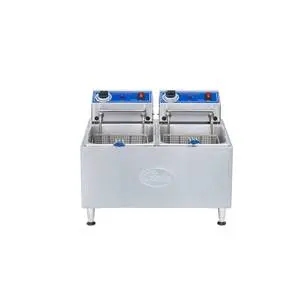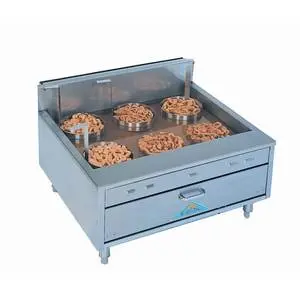Depending on the operation, a deep fryer can be one of the most heavily used pieces of equipment in a commercial kitchen. When purchasing a fryer, as with any piece of large kitchen equipment, there are several factors to take into account before making your purchase. Before purchasing your fryer, take a look at some of the following pointers:
What Are The Types Of Fryers?
There are several different types of fryers out on the market, with different intended uses. Aside from choosing the energy source (electric or gas), there are several other fryer genres on the market. Here’s a brief description of the sorts of fryers you will encounter when shopping.
- Tube Style Fryers – Most floor model fryers will fall into this category. They feature tubes which transfer heat to the oil and rest above the bottom of the fry pot, creating a “cold zone”. This allows sediment, crumbs, etc to settle to the bottom of the fry pot without scorching. This makes them slightly harder to clean than open fry pots just because of the folds and crevices inside of the fry pot, however the oil often lasts much longer, and there is significantly less burned on debris to clean.
- Open Pot & Flat Bottom Fryers – Open pot and flat bottom fryers are heated externally. The fry pot is directly heated, which then heats the oil. Though they are easy to empty, the direct heating process can scorch debris and dirty the oil. These fryers are typically used with foods than don’t create much debris like lightly breaded or battered fish, or things like donuts or funnel cakes. The main difference between an open pot and a flat bottom fryer are the way they drain. An open pot fryer is shaped similar to a tube fryer so the oil funnels downward to its drain, but a flat bottom is literally just that; flat on the bottom.
- Countertop Fryers – Countertop fryers can fit into any of the three aforementioned categories, as there are tube style, open pot, and flat bottom fryers that come in countertop models. Though they are usually smaller, some may hold up to around 30-35 lbs. of oil, which is comparable to a small floor model fryer.
- Rack Fryers – Rack fryers are usually open pot or flat bottom fryers that submerge several racks into the fry pot at one time to be cooked. There are used for cooking large quantities of a single variety of food, such as large quantities of donuts or fried chicken.
- Ventless Fryers – For the most part, fryers require ventilation, as they produce liquid grease exhaust when they are cooking. There are a few models out on the market that are fully enclosed, and contain an internal air filtration system that exhausts steam.
What Type of Fryer Controls Are There?
There are several different ways to control your fryers. They can be made as sophisticated or simple as users prefer, depending on the operation they are fitting into. Here’s a list of the variety of fryer controls you’ll see.
- Millivolt Controls – The most common control switch for a fryer is the standard millivolt. It can be found on only gas fryers, as it controls the gas flow manually, and feeds the appropriate amount of gas to the standing pilot to raise the oil to the proper temperature. It does not directly measure the temperature of the oil so it may be read externally; however, it will turn the burners off when it has reached temperature, and on when it drops below its intended temperature range. It does not require an additional power source.
- SolidState Control – This electric control can be found on both gas and electric fryers. It requires a separate electric power source on gas models, but usually comes standard on electric fryers. A solid state control actually measures the temperature of the oil, and will keep the oil within a degree or two of the temperature it is set to. They also often feature a melt setting for fryers filled with lard or solid fat, and a boil out setting for cleaning.
- Digital Controls – The digital control is similar to the Solid State control, however, rather than a dial, these feature a digital display. They will usually also feature a built-in timer to keep track of cook times. They require additional power when added to a gas fryer.
- Computer Controls – For the most part, a computer control is used to control areas with multiple temperatures, basket lifts, and can store different cook settings in their memory bank. They are traditionally used to control fry banks that are made up of several fryers (see below).
What Is The Right Size Fryer?
It can be hard to determine how much fryer is the right amount. There are fryers that hold around 5 lbs. of oil, and there are fryers that hold over 200 lbs. of oil; a range which can be a bit troublesome for some shoppers. Take the following into consideration before selecting a fat capacity:
- How Much Food Will Be Fried? – This is a twofold question. Look at how many various food items on your menu will be coming from the fryer, and look at the expected volumes / portions they will be fried at. For example, a restaurant that’s only fryer need is to cook French fries for its small or moderate lunch rushes will require a much smaller fryer than a bar that has numerous items coming from the fry unit. However, if that same lunch restaurant starts serving French fries along with every menu item, it would need more fryer space, but not necessarily more fryers.
- How Many Baskets? – One deciding factor to look at when choosing a fryer is how many baskets can be held. Most fryers have options as to how many basket configurations they offer, but more often than not a fryer will only fit 1, 2, or 3 baskets (with 3 baskets usually being in larger fryers). Essentially, a fryer basket should only be filled with things that have the same cook time and won’t cross contaminate before cooking (the hot oil kills anything it touches once the food is submerged and brought to temperature). The need for more baskets should be proportionate to the amount of fryer items on the menu / fryer rush sizes.
- Is A Fry Bank A Better Idea? – Restaurants with high volume fry needs traditionally invest in fry banks. A fry bank is a series of connected fryers that are usually controlled from one central computer or station. They can be programmed with different cook timers, heats, and settings to minimize fry times, and free up space during rushes. Fry banks are essential in fast food and many chain restaurants, and can actually help lower food costs. The basket lifts and timers prevent food from burning by lifting them at proper times. Fry banks are customizable, and can, however, be purchased with any of the standard controls, with different size fryers, and without basket lifts if desired.
- Do I Need A Fryer With A Filter? – Some larger fryers come with filters. Higher capacity fryers usually should be purchased with built-in filters, or one should be bought as an accessory, as high volume frying produces significant debris. This debris clouds oil that would otherwise still be usable, and a filter extends the life of high volume oil significantly. In smaller fryers they are not usually as important. By the time debris and fryer sediment become an issue the oil has usually reached its life expectancy.



